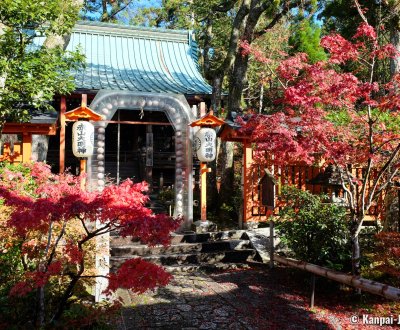Sekizan Zen-in
The Small Autumn Temple in the North of Kyoto
Sekizan Zen-in is a Buddhist temple of the Tendai school at the foot of Mount Hiei, in Sakyo ward in the north-east of Kyoto. Located next to Shugaku-in Imperial Villa, the site is renowned for its flamboyant fall foliage thriving at the end of November. Its little pavilions scattered in the forest mountain offer a nice decor for a walk.
Founded in 888, Sekizan Zen-in temple is affiliated to Enryaku-ji’s Tendai Buddhism. Sekizan Daimyojin is its main deity in a Japanese version of Taizan Fukun, a god that protected Ennin (794 - 864), an eminent priest of the Tendai School, during his travel to China. It is also prayed for good health and a long life.
Retired emperor Go-Mizunoo (1596 – 1680) lived in the neighboring Shugaku-in Villa and greatly contributed to the temple’s maintenance and reputation. He even drew a Sekizan Daimyojin calligraphy as an offering to the sacred place.

Guardian of the demons' gate
The temple was built at this specific location to protect Kyoto’s Imperial Palace’s north-eastern gate (Kimon), that is to say the one by which oni demons may enter. Thus, Sekizan Zen-in is said to offer protection against misfortune. It is home to a statue of Masaru, the monkey 🐒 messenger of the mountain’s gods, that wards off evil spirits holding a gohei paper streamer wand and bells. The wooden sculpture is usually placed on one of the pavilions’ roof.
The temple is also part of Kyoto’s 7 Lucky Gods pilgrimage (Miyako Shichifukujin) and welcomes visitors with wishes as different as being successful in business or cured from asthma. The several little Buddhist and Shinto pavilions scattered in the forest are here to address the worshipers’ concerns and are each dedicated to their own deity, such as:
- Fudo-do, sheltering a statue of Fudo-myoo, one of the 5 Wisdom Kings in relation to fire and pictured with a wrathful expression;
- Jizo-do to pray Jizo, the protector of deceased children and travelers;
- Fukurokuju-do dedicated to Fukurokuju, god of happiness; and,
- Benzaiten-do to worship Benzaiten, the deity of arts, eloquence and knowledge.

Koyo spot lost in the mountains
Sekizan Zen-in is worth the visit in autumn 🍁, when ginkgo biloba and maple trees foliage turn to yellow and vibrant red, with a blazing color palette matching the nuances of green of evergreen pine trees, bamboos and moss. The beautiful natural landscape enhances the spiritual atmosphere of the site.
The walk to the temple’s entrance crosses a small residential neighborhood and a forest. The narrow streets display an air of Japanese countryside rather than of a large city such as Kyoto, and one definitely feel entering another world when walking under the trees.
Sekizan Zen-in is off the touristic beaten tracks to offer more serenity and an enjoyable solitude. Moreover, it is easily reachable from Shugaku-in Imperial Villa or from one of the neighboring and more popular temples such as Manshu-in and Shisen-do.

